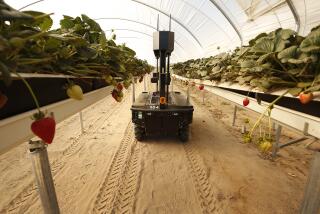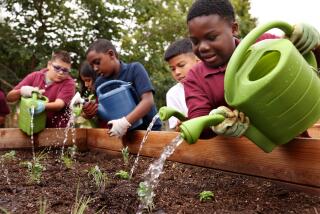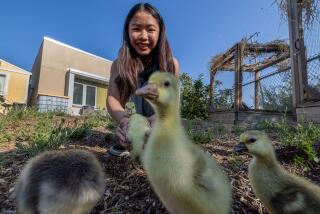Farm Work Serves as Their Homework
With the curiosity and eagerness of a puppy, Jack, a 2-month-old goat, bounded around his home at Canoga Park High School, following his keeper, sophomore Gayle Lewis.
Gayle, 15, cooed as Jack nuzzled her neck.
“His birth was exciting,” Gayle told a visitor, “but also scary because he was too big to come out. He was enormous when he was born and his mother was having a hard time.” Gayle said she caught him before he hit the ground.
Gayle is one of 210 students in the school’s Environmental Agricultural Science Magnet, which provides hands-on experience and guidance.
Many enrolled in the 4-year-old magnet program because they plan to be veterinarians or ranchers.
Most students raise animals to show and sell at the Western Days Fair at school on May 25 and the Valley Fair June 4-7 at the Los Angeles Equestrian Center.
With a detached demeanor that belies their age, the teenagers explained that many of the animals they are rearing will probably be slaughtered--they prefer the word “processed”--for food after they are sold at market.
Other animals kept at the school, including steers, sheep, calves, rabbits and poultry, are used for breeding.
But not all animals in the pens are what most would consider farm animals.
The newest additions are a baby buffalo named Catalina, after the island on which she was born, and an ostrich purchased by a student who is considering cashing in on the latest trend in cuisine.
The students said that in addition to the monetary investment they make in their project animals--from $400 to $1,500 per year, depending on the number of animals--they also commit a lot of time.
They feed the animals each morning before classes, walk them during breaks, and groom, weigh and show them at all hours in between.
“When I’m not in class or at home, I’m usually here,” said Braden Chew, 17. “You just work your animals when you have time. You learn how much time it takes to do one thing or another and so you learn what you can do at a time.”


